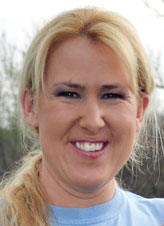
Brett and Jessica Dixon both grew up on family dairy farms and as a result, both developed a love of the industry and the animals involved.
Today, they own and operate Stil Dreamn Dairy, which includes 130 acres with 65 cows in southwest Laclede County, Mo., outside of Conway.
“Brett says his whole life he’s always known he never wanted to do anything but dairy,” Jessica said with a big smile. “He has worked a couple of side jobs along the way and so did I, but this is what we’ve always done.”
Both grew up around Holsteins, but they have discovered other loves along the way – Ayrshires for her and Guernseys for him.
“We found that the colored breeds graze better and last longer, literally live and produce longer, than some other breeds,” Jessica said. “We are currently milking several cows over 10 years old that still calve every year. That’s not uncommon for Ayrshires. They do better for the component market too, producing milk with higher butterfat and protein levels, rather than just depending on the production of pounds of milk, as is the case with Holsteins. Our milk goes to a cooperative and is marketed for evaporated milk and cheese, rather than the liquid milk market.”
Brett added that he and Jessica put a great deal of emphasis on the genetics of their herd.
“We are looking for good conformation, good udders, strong legs – cows that last,” he said. “My father had Guernseys, as well as Holsteins. I find (the Guernseys) to be the best tempered with better components… Besides, they are prettier.”
Both Brett and Jessica showed dairy cattle as teenagers and that is where Jessica first learned about Ayrshires, which were originally developed in Finland and Scotland.
“(Ayrshires) developed on mountainsides so they are really hardy and take the heat well, which some breeds don’t,” Jessica explained. “Ayrshires and Guernseys are more suited to graze. We focus on intensive grazing, which allots us a far greater profit margin than traditional fed and TMR (total mixed rations) dairies.
“We primarily feed several different varieties of ryegrass. We let (the cows) out on grass as we can and only feed grain in the barn. The Ayrshires and Guernseys really excel at going out and grazing compared to a Holstein. It really offers us to cut down out input costs by making the cows go out and eat the grass. It has allowed us to keep milking with almost no input.”
They currently have about 40 paddocks, ranging in size from about an acre and a half to three acres, depending on the grass.
The Dixons are also considering marketing their own grass-fed cheese in the future.
“Cheese is one of the things that Ayrshire milk is ideal for making, so that is an advantage for us,” Jessica said. “It’s also something that is unique for the area and we’ve toured a couple of herds out east that do it. It’s all kind of a dream that it will happen, but if you want to remain in the dairy industry, direct marking is the key to being profitable.”
Brett and Jessica are active on the national level of organizations that support their respective breed of choice. Jessica is a national director for the U.S Ayrshire Breeder’s Association and Brett is a candidate for the National Outstanding Young Guernsey Farmer of the Year.
Jessica said being a leader for the national Ayrshire association keeps her very busy, but she enjoys being able to promote the breed.
“It means going to national meetings and the national convention,” she said. “The best part is getting to help shape the direction of where the breed is going. It is an elected position so it is an honor and opportunity to make positive changes, as well as addressing problems for the association.”
Brett and Jessica still enjoy showing cattle and also market their cattle at various national sales. Jessica said they recently sold cattle at the Iowa Spring Extravaganza and in Louisville, Ky., at the Kentucky Nationals.
“There is a good market for registered (show-quality) cattle and we’ve been able to sell several high-dollar cows to help out when milk prices are low,” Brett said.
The couple added that the market for show cattle doesn’t fluctuate the way normal cattle markets do.
The next generation of Stil Dreamn Dairy is helping out on the farm, too. The couple’s 2-year-old son, Diesel, was quick to find his boots when asked if he wanted to go see the cows.
“He loves the cows, of course,” Jessica said with a laugh.







